Uno de los alimentos milenarios más completos, ricos en hidratos de carbono y múltiples vitaminas que no faltan en nuestra cocina es la pasta; su versátil incorporación gastronómica la ubican en un privilegiado lugar al momento de combinarla con cualquier proteína animal, hongos o vegetales. La ciudad portuaria de Carúpano, localizada en el extremo nororiental de Venezuela, goza de afamado reconocimiento desde mediados del siglo XIX cuando se comenzó a elaborar un exquisito embutido artesanal a base de proteína porcina que es recubierto con vísceras naturales de cochino y se conoce como chorizo carupanero.

Cada vez que viajo para Los Arroyos, mi pueblo natal; paso por esta linda ciudad costeña y tengo una parada obligatoria en el mercado municipal para comprar chorizos carupaneros que los preparo de muchas maneras; verbigracia, en esta ocasión me encantó hacerlos con pasta. Espero sea de tu agrado, comparto la receta contigo.

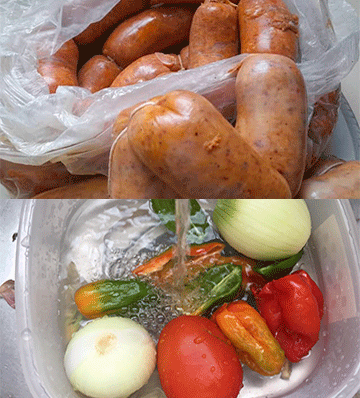
- 1¼ kilo de chorizo carupanero,
- ½ kilo de pasta larga,
- 2 cebollas medianas,
- 20 gramos de ajíes dulces,
- 50 gramos de tomates maduros,
- 7 granos de ajo,
- 3 litros de agua,
- Pimienta negra al gusto,
- Sal al gusto.
 Ajíes dulces, cebollas, ajo y chorizos sofritos.
Ajíes dulces, cebollas, ajo y chorizos sofritos.
En un caldero o paila mediana se agregan los chorizos y se añade ¼ de taza de agua. Se deja cocinar a fuego lento por 25 minutos, manteniendo el caldero tapado durante los primeros 15 minutos.
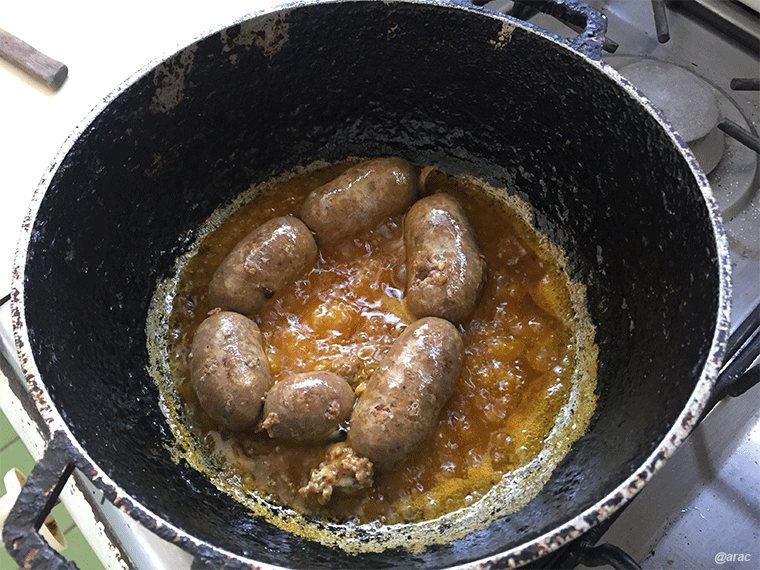
Con este proceso se buscan dos cosas, cocinar el embutido con el vapor de agua y extraer la mayor cantidad de grasas presente en la proteína de carne.
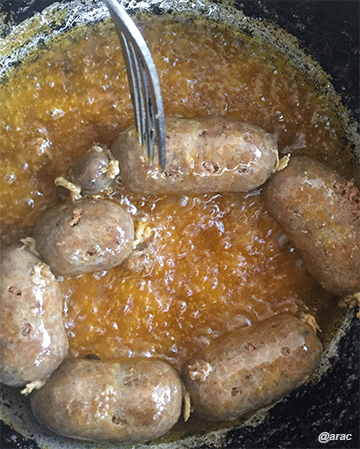
Durante los primeros minutos de cocción comienzan a liberarse los jugos de la cebolla, ajo y ají dulce presentes en el embutido artesanal de cochino y la tripa natural que lo recubre. De esta manera, se combinan con la grasa que termina aromatizada por los mismos componentes, se extrae un poco y se procede a voltear los chorizos para que se doren uniformemente.
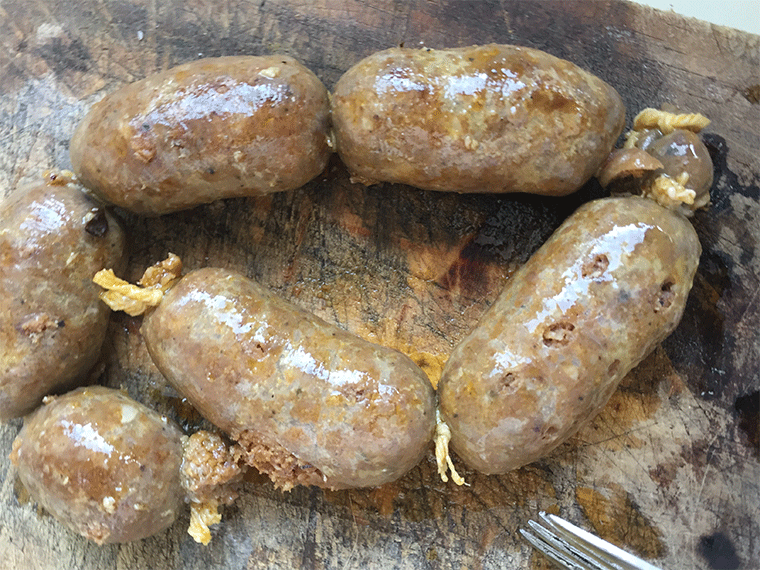 Chorizos sofritos escurriendo en tabla de picar.
Chorizos sofritos escurriendo en tabla de picar.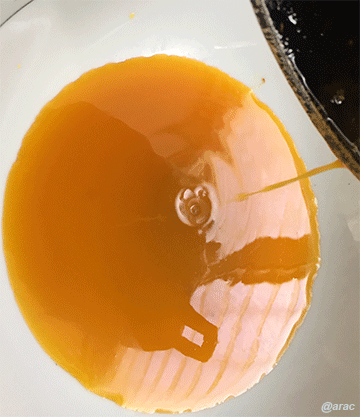
La grasa de los chorizos sofritos se va extrayendo proporcionalmente y guarda en para utilizar un par de cucharadas al momento de preparar la pasta.
El sobrante de este concentrado graso puede guardarse en un envase con tapa y mantener a temperatura o refrigerar con la finalidad de usar en la preparación de arroz, pasta u otros contornos.
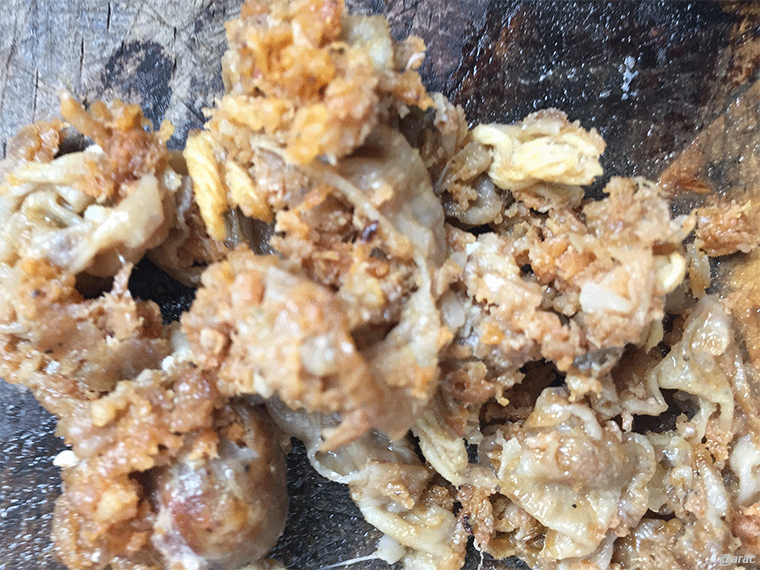
Una vez que los chorizos escurrieron la grasa y se encuentran fríos, es momento de retirar la piel natural que los protege, puesto que estas vísceras contienen gran cantidad de grasa.
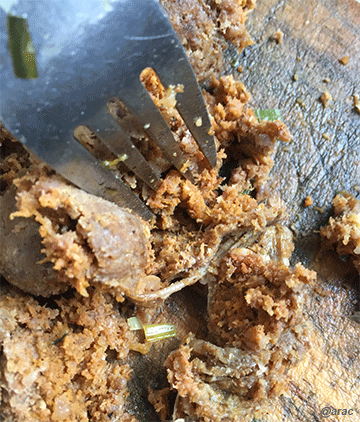
|
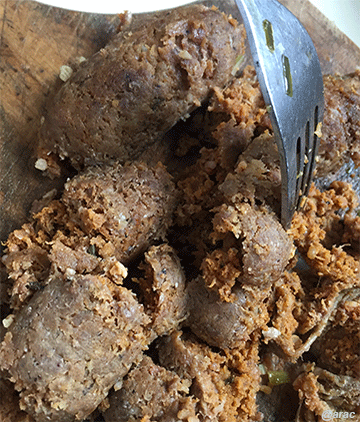
|
El chorizo carupanero es un suculento embutido que se caracteriza por su aromático olor y característico sabor ajo picante que se puede comer sin necesidad de retirar su piel, puesto que es natural y deriva del animal porcino.
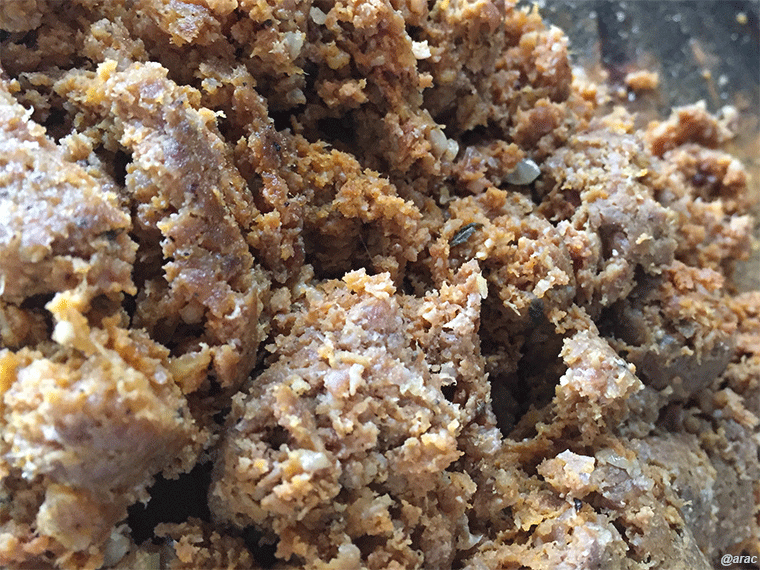 Chorizo sofrito sin tripa.
Chorizo sofrito sin tripa.Sin embargo, cuando se trata de preparación para salsas o guisos como relleno de pasteles, empanadas o arepas, es mejor retirar y desechar la tripa.
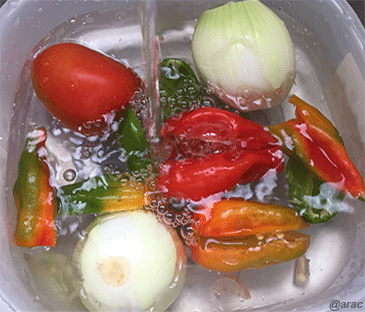
|
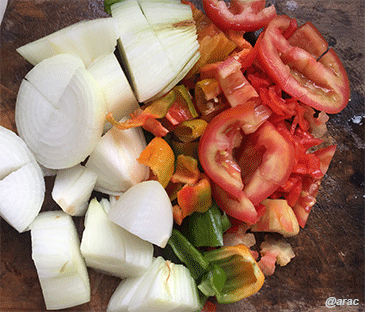
|
Habiendo sacado los chorizos sofritos de la envoltura natural, se procede a lavar y picar los vegetales para licuar y hacer la salsa.
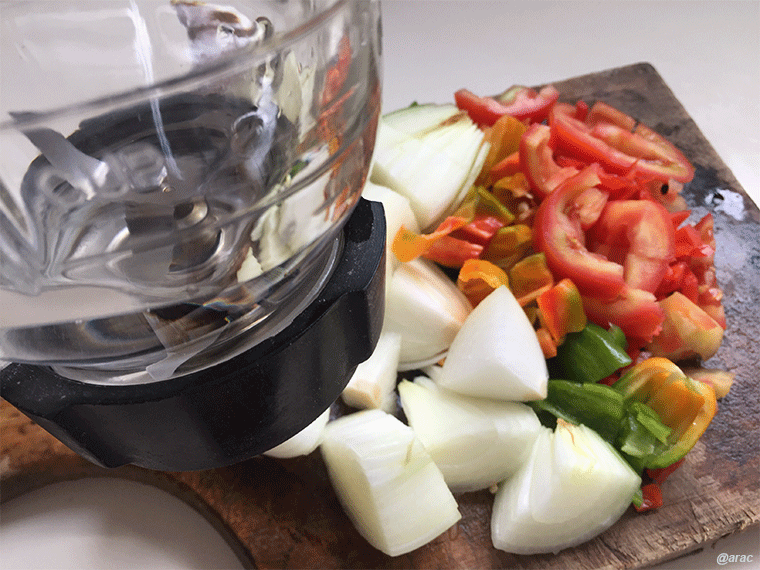
Los vegetales se cortan en trozos medianos, se le retiraran las semillas al tomate.
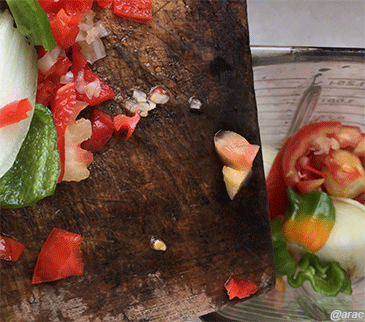
|
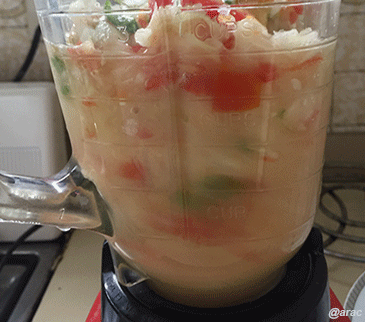
|
Se vierte una taza de agua en el envase de la licuadora y se agregan los vegetales para licuar a velocidad mínima durante dos minutos.

Se calienta el caldero y se añade el embutido sofrito con una pequeña porción de aliños picados, luego se agregar el jugo de vegetales que debe cubrir la proteina en su totalidad.
Se incorpora la pimienta negra y sal al gusto antes de tapar y dejar cocinar a fuego lento por 20 minutos.
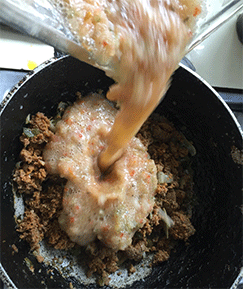
|
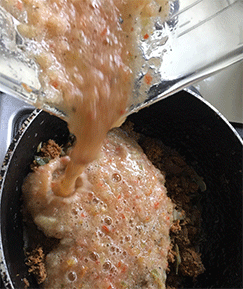
|
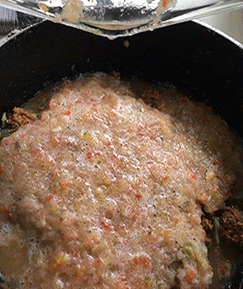
|
Momento en que se incorporan los vegetales licuados.

Cuando la salsa haya hervido unos 10 minutos, se destapa para que evapore un poco el agua y se comience a obtener una viscocidad característica como la mostrada en la imagen anterior.

Al agua para cocinar la pasta se le añade dos cucharadas de la grasa que se le extrajo a los chorizos al momento de sofreirlos; esto proporciona un sabor agradable que será absorbido por la pasta.
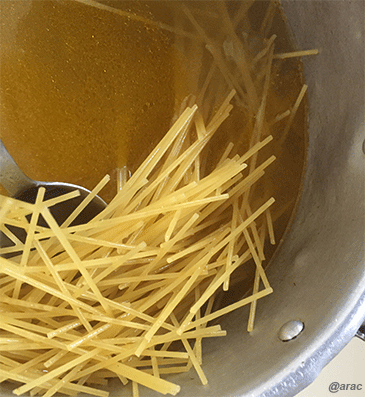
|
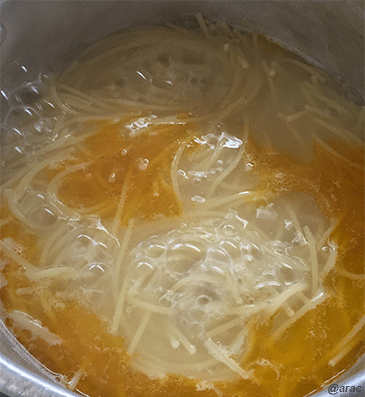
|
Se agrega la pasta y deja cocinar por 12 minutos a fuego intermedio y semi tapado. Transcurrido este tiempo, la salsa se encuentra lista para servir con la pasta caliente.
Plato servido
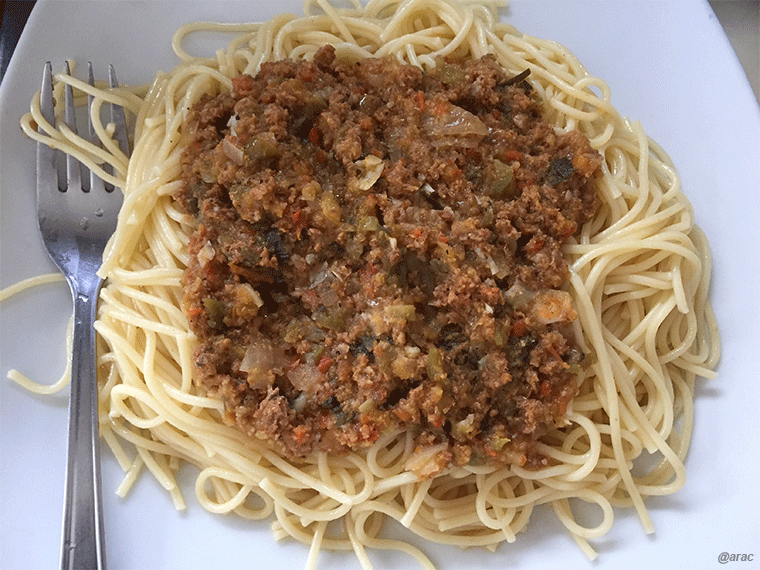
Después de 50 minutos, nuestra salsa de chorizo carupanero se encuentra lista para comer con pasta caliente. Puedes añadir un poco de queso rallado para combinar sabores y tener una experiencia a tu antojo.
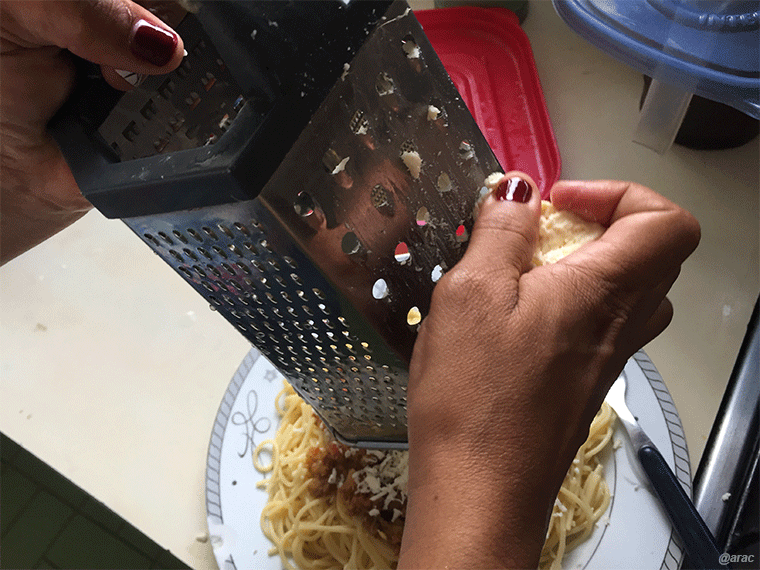
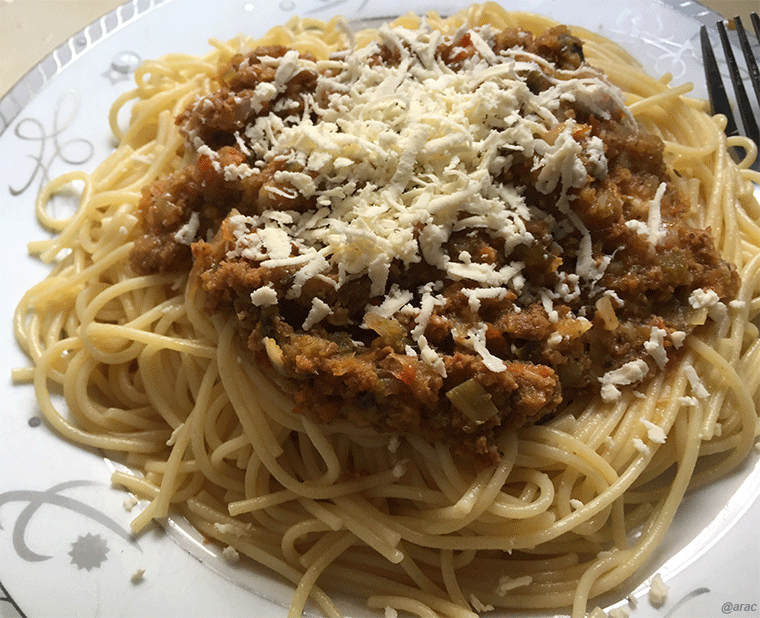
De esta forma preparé la salsa de chorizo carupanero con pasta, espero que la receta haya sido de tu agrado. ¿Por cierto, has comido chorizo carupanero? Son unos de los mejores embutidos artesanales que se preparan en la ciudad costera de Carúpano... Hasta una próxima receta.

English version
Pasta is one of the most complete millenary foods, rich in carbohydrates and multiple vitamins that are always present in our cuisine; its versatile gastronomic incorporation places it in a privileged place when combined with any animal protein, mushrooms or vegetables. The port city of Carúpano, located in the northeastern end of Venezuela, enjoys famed recognition since the mid-nineteenth century when it began to produce an exquisite handmade sausage based on pork protein that is coated with natural pig viscera and is known as carupanero sausage.

Every time I travel to Los Arroyos, my hometown, I pass through this beautiful coastal town and I have an obligatory stop at the municipal market to buy chorizos carupaneros that I prepare in many ways; verbigracia, on this occasion I loved to make them with pasta. I hope you like it, I share the recipe with you.


- 1¼ kilo of carupanero sausage,
- ½ kilo long pasta,
- 2 medium onions,
- 20 grams of sweet peppers,
- 50 grams of ripe tomatoes,
- 7 grains of garlic,
- 3 liters of water,
- Black pepper to taste,
- Salt to taste.
 Sweet peppers, onions, garlic and sausages, sautéed.
Sweet peppers, onions, garlic and sausages, sautéed.
In a medium caldero or paila add the chorizos and add ¼ cup of water. Simmer for 25 minutes, keeping the pot covered for the first 15 minutes.

The aim of this process is twofold: to cook the sausage with the steam and to extract the maximum amount of fats present in the meat protein.

During the first minutes of cooking, the juices of the onion, garlic and sweet bell pepper present in the handmade pork sausage and the natural casing that covers it begin to be released. In this way, they are combined with the fat that ends up flavored by the same components, a little is extracted and the chorizos are turned over so that they brown evenly.
 Sauteed sausages draining on chopping board.
Sauteed sausages draining on chopping board.
The fat from the sautéed sausages is proportionally extracted and saved in order to use a couple of spoonfuls at the moment of preparing the pasta.
The surplus of this fat concentrate can be stored in a container with a lid and kept at temperature or refrigerated for use in the preparation of rice, pasta or other contours.

Once the sausages drain the fat and are cold, it is time to remove the natural skin that protects them, since these visors contain a large amount of fat.

|

|
Carupanero chorizo is a succulent sausage characterized by its aromatic smell and characteristic spicy garlic flavor that can be eaten without removing its skin, since it is natural and derived from the porcine animal.
 Chorizo sofrito sin tripa.
Chorizo sofrito sin tripa.However, when it comes to preparation for sauces or casseroles as a filling for pies, empanadas or arepas, it is better to remove and discard the tripe.

|

|
Once the sausages have been removed from the natural casing, the vegetables are washed and chopped to blend and make the sauce.

The vegetables are cut into medium-sized pieces, the seeds are removed from the tomato.

|

|
Pour one cup of water into the blender container and add the vegetables to blend at minimum speed for two minutes.

Heat the cauldron and add the sautéed sausage with a small portion of chopped seasonings, then add the vegetable juice that should cover the protein in its entirety.
Add black pepper and salt to taste before covering and simmering for 20 minutes.

|

|

|
When the liquefied vegetables are incorporated.

When the sauce has boiled for about 10 minutes, it is uncovered so that the water evaporates a little and a characteristic viscosity as shown in the previous image begins to be obtained.

To the water used to cook the pasta, add two tablespoons of the fat extracted from the sausages when frying them; this provides a pleasant flavor that will be absorbed by the pasta.

|

|
Add the pasta and cook for 12 minutes over medium heat and half covered. After this time, the sauce is ready to serve with the hot pasta.
Plate served

After 50 minutes, our carupanero sausage sauce is ready to eat with hot pasta. You can add a little grated cheese to combine flavors and have an experience to your liking.


This is how I prepared the carupanero sausage sauce with pasta, I hope you liked the recipe. By the way, have you ever eaten chorizo carupanero? They are one of the best handmade sausages that are prepared in the coastal city of Carúpano? See you in the next recipe.

Translated with www.DeepL.com/Translator (free version)
Imágenes | Images
Todas las imágenes pertenecen a la autora. Las capturas se efectuaron con dispositivo móvil iPhone 6. Se utilizó el programa Adobe Photoshop CS6 para elaborar la imagen principal y reducir el tamaño a los archivos en formato PNG.
All images belong to the author. The images were taken with an iPhone 6 mobile device. Adobe Photoshop CS6 was used to create the main image and reduce the size to PNG format files.
Yum! You have been curated @bahagia-arbi on behalf of FoodiesUnite.net on #Hive. Thanks for using the #foodie tag. We are a tribe for the Foodie community with a unique approach to content and community and we are here on #Hive.
Join the foodie fun! We've given you a FOODIE boost. Come check it out at @foodiesunite for the latest community updates. Spread your gastronomic delights on and claim your tokens.
Join and Post through the Community and you can earn a FOODIE reward.
Thank you for your support
Your content has been voted as a part of Encouragement program. Keep up the good work!
Use Ecency daily to boost your growth on platform!
Support Ecency
Vote for new Proposal
Delegate HP and earn more
Thank you for your support
I love this recipe, I think it is very delicious. Thank you for sharing, I will try it out. Good afternoon!
I am glad you liked this recipe. It really is a very delicious dish.
Congratulations, your post has been upvoted by @dsc-r2cornell, which is the curating account for @R2cornell's Discord Community.